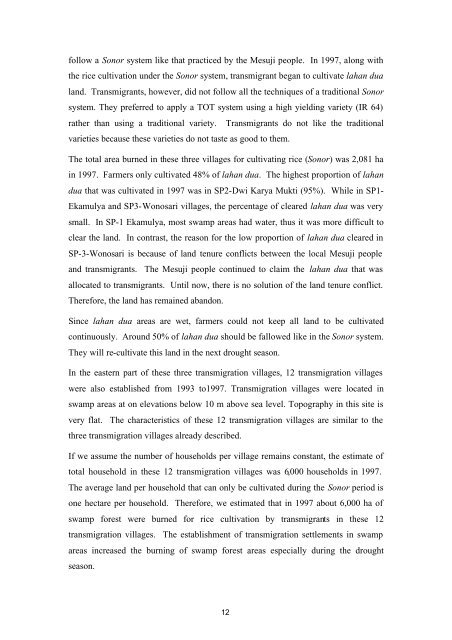English - Center for International Forestry Research
English - Center for International Forestry Research
English - Center for International Forestry Research
You also want an ePaper? Increase the reach of your titles
YUMPU automatically turns print PDFs into web optimized ePapers that Google loves.
follow a Sonor system like that practiced by the Mesuji people. In 1997, along with<br />
the rice cultivation under the Sonor system, transmigrant began to cultivate lahan dua<br />
land. Transmigrants, however, did not follow all the techniques of a traditional Sonor<br />
system. They preferred to apply a TOT system using a high yielding variety (IR 64)<br />
rather than using a traditional variety. Transmigrants do not like the traditional<br />
varieties because these varieties do not taste as good to them.<br />
The total area burned in these three villages <strong>for</strong> cultivating rice (Sonor) was 2,081 ha<br />
in 1997. Farmers only cultivated 48% of lahan dua. The highest proportion of lahan<br />
dua that was cultivated in 1997 was in SP2-Dwi Karya Mukti (95%). While in SP1-<br />
Ekamulya and SP3-Wonosari villages, the percentage of cleared lahan dua was very<br />
small. In SP-1 Ekamulya, most swamp areas had water, thus it was more difficult to<br />
clear the land. In contrast, the reason <strong>for</strong> the low proportion of lahan dua cleared in<br />
SP-3-Wonosari is because of land tenure conflicts between the local Mesuji people<br />
and transmigrants. The Mesuji people continued to claim the lahan dua that was<br />
allocated to transmigrants. Until now, there is no solution of the land tenure conflict.<br />
There<strong>for</strong>e, the land has remained abandon.<br />
Since lahan dua areas are wet, farmers could not keep all land to be cultivated<br />
continuously. Around 50% of lahan dua should be fallowed like in the Sonor system.<br />
They will re-cultivate this land in the next drought season.<br />
In the eastern part of these three transmigration villages, 12 transmigration villages<br />
were also established from 1993 to1997. Transmigration villages were located in<br />
swamp areas at on elevations below 10 m above sea level. Topography in this site is<br />
very flat. The characteristics of these 12 transmigration villages are similar to the<br />
three transmigration villages already described.<br />
If we assume the number of households per village remains constant, the estimate of<br />
total household in these 12 transmigration villages was 6,000 households in 1997.<br />
The average land per household that can only be cultivated during the Sonor period is<br />
one hectare per household. There<strong>for</strong>e, we estimated that in 1997 about 6,000 ha of<br />
swamp <strong>for</strong>est were burned <strong>for</strong> rice cultivation by transmigrants in these 12<br />
transmigration villages. The establishment of transmigration settlements in swamp<br />
areas increased the burning of swamp <strong>for</strong>est areas especially during the drought<br />
season.<br />
12
















